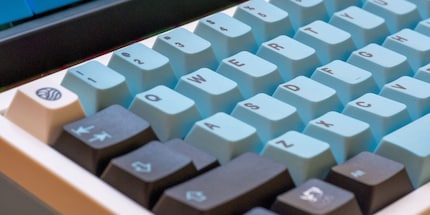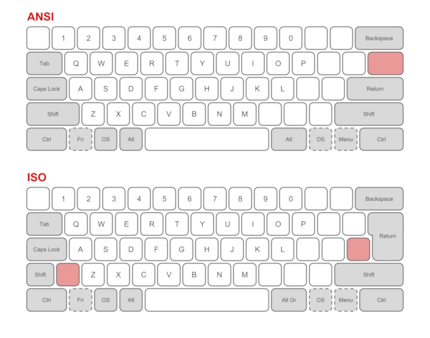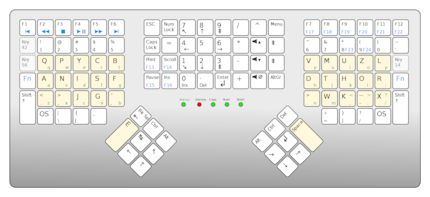
Background information
Crazy keyboards: from quirky to downright nuts
by Kevin Hofer

The QWERTZ keyboard layout seems ubiquitous in the German-speaking world. Still, not even the DE and CH assignments are identical. A look at layouts from around the world.
I’ve been using keyboards for as long as I can remember. First using the search-and-type system, then transitioning to all ten fingers. These days, my fingers virtually fly across the keyboard. In part because I’ve got so used to our layout. If I had to write using a different assignment, I’d be screwed. I can barely manage a Mac, struggling to remember where to find the «@».
But there’s not only differences between Mac and Windows. As Swiss users, we sit in a small bubble. The CH key assignment already differs from DE. We use Alt Gr + 2 for «@» while my German colleague Jan Johannsen presses Alt Gr + Q. Both key bindings are based on the QWERTZ layout.

In truth, QWERTZ or QWERTY are both cumbersome. Many frequently used keys lie far apart. Requiring my fingers to overcome long distances. Why is that? Inventor Christopher Sholes developed QWERTY in 1868 to stop hammers on mechanical typewriters from jamming. Which is exactly why he spaced out frequently used letters. The same applies to offset keys, by the way. All this is no longer necessary with today’s computer keyboards. Nevertheless, most key layouts are based on QWERTY.
Our nearest relative is likely the QWERTY key layout, as used in most English-speaking countries. But this assignment is also common in Spain or Brazil. There’s only one difference among all 26 letters of the alphabet: Z and Y are interchanged. This is because, in German, Z occurs more frequently than Y.


The strange thing about QWERTY isn’t so much the layout itself, but that it’s used in both ANSI and ISO. Here’s what I mean:

The USA uses the ANSI layout, the UK prefers ISO. But both use the QWERTY arrangement. As Obelix says: these Yanks/Brits are crazy.
Our French-speaking neighbours rely on AZERTY. Q swaps places with A, W moves to Y’s place, and the latter takes the place of Z. Finally, Z goes where W used to be. All right? Belgium and Luxembourg also rely on it, but there are country-specific differences. To make things even more complicated, Luxembourg relies on CH key mapping in schools and public administrations. These Gauls are crazy.

Another French key mapping. Turns out the French aren’t just satisfied with AZERTY. BÉPO is an alternative. The home row on this keyboard layout contains the most frequently used letters of the French language. A home row is the one on which your fingers rest when using the ten-finger system. So it should be easier to type. In addition, diacritic letters have their own key here.

Until now, all these layouts can be guessed from the letters at the top left of the keyboard. This isn’t the case with Dvorak. The key layout was named after its inventor, August Dvorak. He found QWERTY inefficient and came up with Dvorak in 1936. About 70 per cent of keystrokes should take place on the home row with this layout – at least in English. Moreover, most inputs are made with the right hand. This was Dvorak’s intention, as most people are right-handed.

Colemak is a portmanteau of its inventors, Coleman and Dvorak. Coleman wanted to eliminate problems with the Dvorak key layout using this mapping, thus facilitating a switch from QWERTY to Colemak. Compared to QWERTZ/QWERTY, only 17 changes have been made.

Maltron isn’t just its own keyboard layout, but also a manufacturer that has been active since the 1970s. They specialise in ergonomics and barrier-free access. Maltron, for example, also offers one-armed keyboards and ones that can be operated with a head/mouth stick. As with Dvorak, frequently used keys are on the home row. The manufacturer relies on an ortholinear arrangement for this. Keys are therefore no longer staggered, but lie one below the other in a chequerboard pattern.

All the key bindings shown so far have something in common: they use the Latin alphabet. Russia uses the Cyrillic alphabet, meaning their layout is also different. JCUKEN has been the standard layout for Russian keyboards/typewriters since 1917. Nevertheless, the keyboard is based on QWERTY. By the way, this also applies in countries with other writing systems.

Switzerland has around 8.6 million inhabitants. Worldwide, the figure will soon reach eight billion. Nevertheless, we have our own keyboard layout. I’ll admit: given our four national languages, it makes sense for all our buttons to be labelled accordingly. Different key systems within Switzerland would be strange.
Nevertheless, when you consider that custom printed keycaps are being made specifically for Swiss users, it’s crazy. And most of us can’t imagine writing any other way – even if there were more efficient ways to type. Dvorak and Colemak lead the way in this aspect. But we stick with the inefficient out of habit. Still, it’s good to look outside our comfort zone and see how others are doing it. I feel like trying Colemak now.
From big data to big brother, Cyborgs to Sci-Fi. All aspects of technology and society fascinate me.
Interesting facts about products, behind-the-scenes looks at manufacturers and deep-dives on interesting people.
Show all